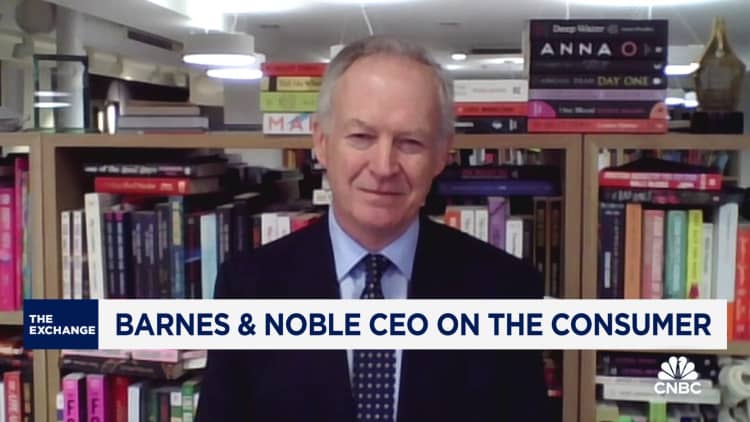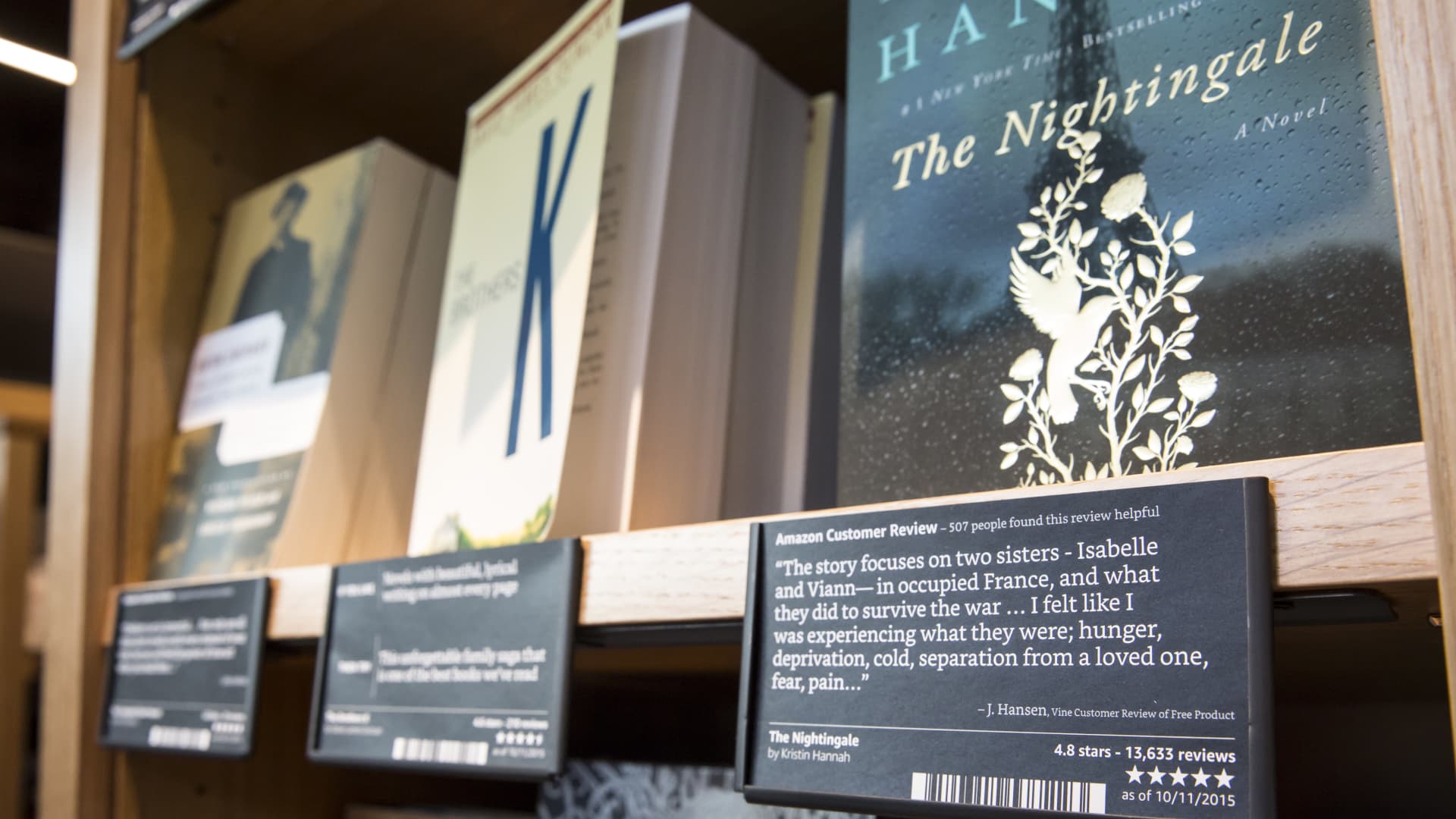Snippets from online Amazon customer reviews as well as star ratings are displayed for books at one of the original Amazon Books stores opened in Seattle, Washington in 2015. In 2022, Amazon shut down its physical bookstore business.
Stephen Brashear | Getty Images News | Getty Images
Within its first month of coming to life as an online bookstore in 1995, Amazon.com had shipped books to all 50 states. By 1997, it had shipped its one millionth order (hand-delivered by Jeff Bezos himself). So there’s something emblematic in how the company that billed itself as “earth’s biggest bookstore” has continued to evolve its bookseller business across three decades as it became an everything store, a retail giant with Whole Foods and various experiments in the bricks-and-mortar world, a global logistics provider, the country’s largest cloud computing services vendor, and most recently, a major generative AI investor.
For all of its time spent in books — and what its success has done to the bookstore business — there are still some issues that Amazon has to work out with readers. In the middle of December, Amazon rolled out a new service, Your Books, aiming to tackle some of the challenges it still faces in helping users build a library that they turn to more often.
It starts with customer reviews, one of the oldest features on Amazon, and an integral part of its capacity as a bookseller. Helping customers to find their next book, through reviews and recommendations, is central to at least approximating the bricks-and-mortar bookstore experience, where customers could physically browse the shelves and speak with staff who may have known their tastes well.
Reviews extend to all Amazon products, but with books there is an additional significance. Buying razor blades or sponges online doesn’t entail much of a lost experience compared to making the transaction in a physical store, but being in a bookstore comes with accidental discoveries — perusing shelves and a community of readers bundled into the book-buying experience.
To help overcome this, over the years Amazon has added all types of reviews, ratings, and recommendations — some human, some algorithmic and AI-generated. In perhaps its clearest nod to the importance of community to readers and book buyers, Amazon bought Goodreads, the online forum where book lovers discuss books, in 2013. This human approach has obvious benefits, but has led to its own set of problems — all too-human ones — such as the recent scandals surrounding Goodreads–authors “review-bombing” competitors’ books.
All of this may have played into Amazon’s launch of Your Books. The company describes it as a “personalized space” to aggregate information related to a customer’s whole history of book purchasing on Amazon — including its Kindle and Audible businesses — and receive recommendations based on reading tastes, and insights into personal reading habits.
“With Your Books, customers can access a highly personalized experience across all of their past purchases, use filters to explore their library, and activate ‘discovery mode’ to get recommendations tailored to their interests,” said an Amazon spokeswoman. There is a link to past extensions of the Amazon book brand by bringing together a customer’s history with community-building features such as Goodreads, the spokeswoman said, overlaying Goodreads discovery, community, and reviews experience.
Your Books represents more of a reordering of existing features than something entirely new. “Amazon customers have always been able to get book recommendations and access their book purchases and wish list items,” the spokeswoman said.
Physical books still far outsell e-books, audiobooks
The digital bookshelf, at its simplest level, mimics an actual bookshelf, and that underscores another factor that Amazon still has to account for: the endurance of the book as a physical object. People like to see and display what they’ve read. It shows them who they are, in a way that few other objects can. And people still like to buy physical books more than e-books or audio format.
According to the Association of American Publishers, physical books continue to outsell e-books and audiobooks by a wide margin. Its latest annual data through October 2023 reported $10.6 billion in sales over the first 10 months of the year, with the consumer books business representing $7.4 billion. Of that, hardcovers were $2.7 billion and paperbacks were $2.6 billion — more than 70% of all sales. E-books were at $836.1 million, and digital audio at $699.2 million.

Tech-enabled book competitors have faced their own growing pains, as have some of Amazon’s book efforts more broadly. Audible just announced a round of layoffs, one among many Amazon units to be reducing headcount. In late 2022, Amazon cut jobs in its hardware division, where Kindles are housed, and earlier that year, it shuttered the locations in its experiment running physical bookstores, where sales growth had lagged other retail units.
For Your Books to really pay off, presumably, it has to lead readers to their next online purchase, or as the spokeswoman put it, “connect them to their next great read.”
Independent booksellers have not gone away
While this may be one more risk to add to the Amazon-threat era for independent booksellers, recent data has shown the bookstore business on the local level to be a resilient one. A multi-year study of independent bookstores in the U.S. by Harvard Business School professor Ryan Raffaelli published in 2020 found inherent value in the business model amid the continued growth of Amazon. His study cited data from the American Booksellers Association that showed a 49% growth rate in the number of independent booksellers over the decade from 2009 (1,651 stores) to 2018 (2,470 stores).
The period after Amazon’s 1995 launch did significant damage to the bookstore business, with the ABA reporting a 43% drop in book stores five years after Amazon’s first year in business, and the rebound only began in the decade starting 2009 — two years after the introduction of the Kindle in 2007. But it is a turnaround that Raffaelli attributes to elements of the bookstore model that are hard to recreate in a virtual-only world.
The power of recommendations, in the form of direct conversations with buyers, as well as curating the bookstore collection itself, has proved essential to independent bookstores who have not only survived but thrived in Amazon’s wake. “Independent bookstores have been able to compete with Amazon by cultivating deep relationships with readers and authors,” Raffaelli said. Recommendations and curation are at the heart of this. “Such relationships represent the passion ‘indie’ bookstore employees have for reading, and their longstanding commitment to share the next great book with others. It’s considered a sacred act of community-building,” he said.
NEW YORK, NY – FEBRUARY 27: Customers shop for books at the Argosy Book Store, the New York City’s oldest independent bookstore which was founded in 1925, on February 27, 2023 in New York City. (Photo by Liao Pan/China News Service/VCG via Getty Images)
China News Service | China News Service | Getty Images
Goliath is going to continue to win on price and inventory, but David should not try to be the biggest bookstore on earth anyway.
“Rather than compete with Amazon on price and inventory … booksellers possess a unique ability to find unexpected hidden gems in their stacks – whether it be up-and-coming authors or unexplored genres – that online algorithms have yet to replicate,” Raffaelli concluded.
It could be argued that the algorithms and the knowledgeable bookseller have similar aims, both attempting to help readers discover books they will appreciate. And algorithms curating artistic content for consumers are getting much better at recreating a personal touch, such as Spotify’s playlist selection, though they very much remain works in progress.
But independent booksellers are, not surprisingly, loathe to accept the comparison.
“Their algorithms perform the function they want them to, which is to make them more money,” said Robert Martin, executive director of the Independent Booksellers Consortium, founded in 1993.
Everyone selling books wants to generate more sales, but Martin says the risk with algorithms is sacrificing autonomy for convenience. Generating new recommendations that adhere tightly to previous likes has a tendency to create a reading bubble. “It’s a very real danger, and one that independent publishers and independent booksellers are constantly actively fighting by ensuring diverse voices, genres, and styles get the platforms they deserve,” Martin said.
For Martin, actual recommendations from other readers and informed booksellers in a bookstore is the point, however inefficient or uncontrollable such a recommendation mechanism might be. “I’d rather try to convey my experience or understand how another human feels and maybe not get it totally right than be guided by a robot,” he said. The best way to find your next great read, he says, is by “talking to the friendly and knowledgeable booksellers at your local independent bookstore.”

